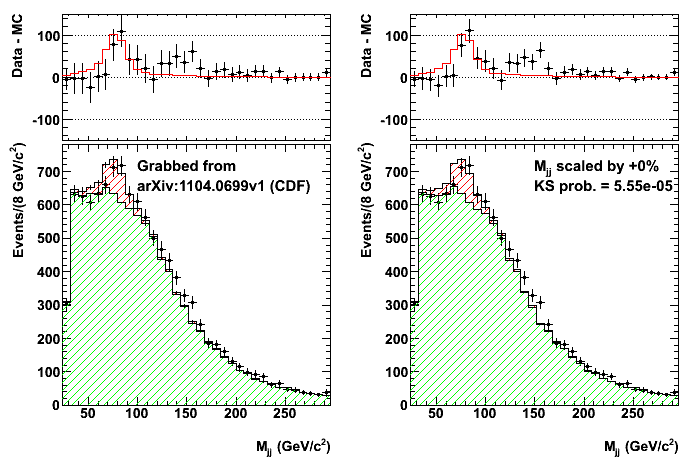Please consider the publication
by the CDF-Collaboration, already with huge media attention. I must admit that I am puzzled, astonished and excited at the same time. Not being an expert, it would be really nice if someone could shed light on the following question they posed:
Did we find a fifth fundamental force that cannot be explained by the standard model?
What do you think?
PS.: A part of figure 1 in the publication that is re-printed over and over again:

Answer
The likely answer is No, the whole signal is just an artifact of the difficult statistical manipulations. A Weizmann Institute physicist has noted that the peak has been shifted by one bin and the whole discovery could therefore be due to a pile-up effect or jet energy calibration; a small shift of the jet energy removes the effect. See also
http://motls.blogspot.com/2011/04/fermilab-cdf-new-force-press-conference.html
for more details. Additional doubts about the valid statistical procedures were mentioned on Tommaso Dorigo's blog, too.

An adjustment of jet energy by 3 percent is enough to make the signal totally insignificant. Animation by Tommaso Tabarelli de Fatis, a member of CMS.
The text above also reviews some theoretical literature and clarifies that if the signal happens to be real - and the D0 Collaboration is going to release its own verdict about the phenomenon in a few weeks - the most likely explanations are
a new, fifth force - one mediated by a Z' boson (with the mass of 144 GeV or so) which is the particle that was decaying to two jets in those events. It must be leptophobic - (almost) no interactions with the leptons - and such Z' bosons, messengers of new $U(1)$ groups similar to the electroweak Z' boson but independent from them, are predicted by a very large fraction of grand unified theories and/or string theory models; articles by Alon Faraggi and many others are listed above; the simplest (but not the only) way to get a new leptophobic $U(1)$ is to obtain it as a piece of a color $SU(4)$ broken to $SU(3)\times U(1)$
a technipion, a particle analogous to a pion in technicolor theories that break the electroweak symmetry by similar composite particles, and not necessarily scalar ones (so there is no true Higgs particle in those theories); a paper by Kenneth Lane et al. is linked above, too; technicolor has been thought to be nearly dead for years - the optimistic proposal to interpret the bump as a technicolor effect doesn't solve all the detailed problems with technicolor theories
a stop squark in a supersymmetric theory - but it must be an R-parity-violating version of supersymmetry (e.g. because the new superpartners were not produced in pairs) which is unattractive for many other reasons (in simple terms, R-parity-violating theories are only consistent with proton stability given immense new assumptions, and they don't produce natural well-behaved dark-matter candidates); an article is linked to by the weblog above, too
No comments:
Post a Comment